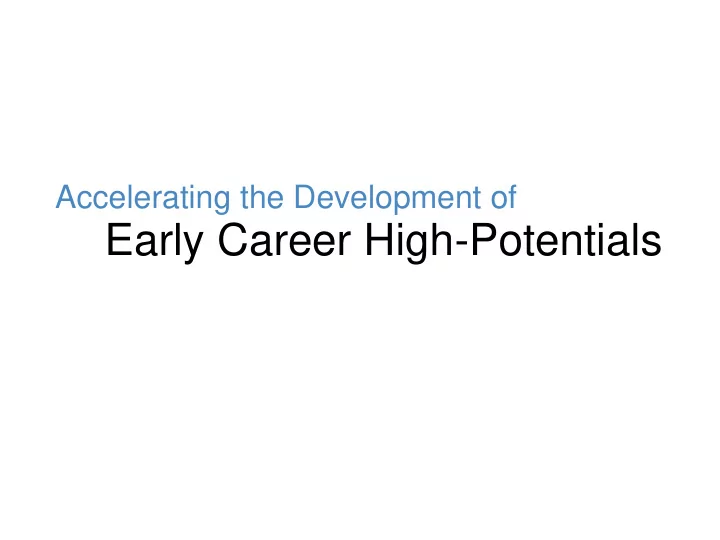

Accelerating the Development of Early Career High-Potentials
Who is BD? • Becton, Dickinson & Company founded in 1897 • Medical technology company headquartered in Franklin Lakes, NJ – Medical Devices – needles, syringes, intravenous catheters, insulin syringes and pen needles – Diagnostics – safety engineered blood collection products, molecular testing for infectious diseases, rapid diagnostics – Biosciences – cell sorters, analyzers and imaging systems • Over $8 billion in revenue (60% revenue from outside of U.S) • 30,000 associates located in over 50 countries 2
Business Case for High Potential Development Six years ago… • Took too long to fill critical open roles • Successor readiness was inadequate in terms of: – “Ready now” successors – Percentage of positions with no successors • Internal hires succeeded at a far greater rate than external hires • Succession candidates below the “ready now” category lacked: – Specific developmental experiences – Exposure to a variety of businesses 3
Leadership Accelerator Strategy Candidates for BDLT roles (i.e., top 50 roles in company) BDLT GM Candidates for General Manager or President Accelerator of a business or region Program Candidates for leadership team roles within a Mid-Career WW business, region or WW function Leadership Accelerator Program Facilitate career development and networking of early-career, high Early Career Experience potential talent
Early Career Experience 5
Overview Purpose • The Early Career Experience is a 24-month leadership experience that accelerates the career development and networking of high-potential, early-career associates Selection Criteria • Participants nominated by their business through a stringent nomination and vetting process. Selection criteria includes the following: – No more than 7 years total work experience (minimum of 1 year at BD) – Viewed as high potential or high performer with potential in PXP matrix – Must have the desire to take on more challenging opportunities – Must be open to geographic mobility 6
Desired Outcomes • Understand the business • Build a personal network • Identify next potential career move • Develop critical competencies • Increase retention and mobility 7
Key Program Elements • Four Sessions: 20 days over 18 months • Mentoring Relationship: 60-90 minute meeting approximately once per month, for 12 months • Corporate Social Responsibility Project: 6 months • Business Improvement Project: 6 months • Other Inter-Session Activities: Webinars, peer group activities, individual work, etc. 8
High Level Design • Create Development Plan • Ongoing Mentoring Business Improvement • Kick off Mentoring Process • CSR Project Projects Session # 1 2 3 4 July February August March Date US Belgium Shanghai US Location Business Knowledge Medical Biosciences Diagnostics BDX BD Medical Customers Various players in social Economist Intelligence Unit ECE Grant Winner Outside Perspective investment arena (Hong Kong) Beneficiary (e.g., UNICEF) BD Biosciences Customers Strategic Planning Working Effectively Across Virtual Teams Leadership Skill Development Cultures Communication Career Development Yankees Game Belgian Beer Competition Shanghai Expo Broadway Show Exposure to Global Cultures/Fun Culinary Team Building Drum Café Chinese culture workshops 9
Accelerate Group Cohesiveness • Creating a high stakes environment where participants had inter-dependent goals • Rotating small group assignments • Participating in fun team activities that resonate with young people • Enjoying once-in-a-lifetime cultural experiences 10
Corporate Social Responsibility Projects • Purpose – Increase understanding of corporate citizenship by working with external partners – Demonstrate global leadership and collaboration – Improve ability to work in global teams • Design – Six global teams charged with identifying a non-profit organization with whom they would partner on a project aligned with BD’s mission – Teams compete for two $10,000 BD grant (consisting of cash and BD products) – Challenge is to propose a project that leverages the contributions of both BD and non- profit partner to maximize impact consistent with BD’s mission – Proposals evaluated by a panel of experts in social investment space CSR projects foster pride in and commitment to the company’s values and mission 11
Business Improvement Projects • Purpose – Obtain in-depth exposure to a new business – Increase business acumen – Address a real growth opportunity for the company • Design – 6-month duration – Projects identified with the support of CEO and Management Committee – Each project has senior executive sponsor and the following characteristics: • Feasible to be completed within 6-month time frame • Business impact to BD • Learning opportunity for participants • Unique opportunity – Structure provided to support team effectiveness, data collection, consulting skills and presenting recommendations to a senior executive panel Rigorous experiential learning activity was a highlight for many participants 12
Career Planning Timing Activity • 360-degree feedback assessment First 18 months • Individual development plan • Mentoring relationship • Career development workshop • Post-program 360 Final six months • Career Blueprint • One-on-one coaching with program leader • Post-program meeting between ECE graduate, their executive sponsor and the executive sponsor’s HR Business Partner 13
Measurable Outcomes • Understand the business • Build a personal network • Identify next potential career move • Develop critical competencies • Increase in retention and mobility Cohort 1 Cohort 2 Total Turnover 7.62% 3.70% Top Potential Turnover 5.33% 0.00% Mobility 88.5% 87.5% Compared to 8% average annual turnover of control group during same time period 14
Lessons Learned 1. Organizational support is critical to success 2. Engage participants’ managers 3. Minimize the use of HR leaders as mentors 4. Peer feedback is a keeper 5. Systemic talent management is essential for continued, post-program development and mobility – Create a talent brokering council – Implement formal process for developmental assignments – Create a consulting pool consisting of program graduates 15
Questions 16
Recommend
More recommend